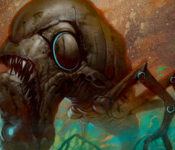
Darksteel: Master Blaster Review (Part 2 of 2)
It’s our last visit to the world of Mirrodin for awhile, as we’re concluding with Darksteel and likely won’t be back until Fifth Dawn. It’s been a fun return, and we’re ending on a high with a look at Master Blaster. To try and thwart me, Jimi’s grabbed the modular-filled Transference. Which deck will come out on top?

Darksteel: Master Blaster Review (Part 1 of 2)
Gen-X quiz time! Imagine for a moment that you’re a young musician in a rock band. You get up on a Saturday morning, head with your friends to your rehearsal space, and begin jamming out to your signature tune. Suddenly, a nearby mirror clouds over, and a sinister figure declares that he’s kidnapping you to a fantasy realm, where you’ll be transformed into cartoon characters and forced to play as his ‘musical slaves… forever!’ It might sound preposterous, but hey, this was the stuff of pop culture television in the early 80’s. The show was Kidd Video, and the villain? Well…

Darksteel: Swarm & Slam Review (Part 2 of 2)
It’s go time for the tokens deck as Swarm & Slam takes the field. Joining me at the table is Jimi, who is piloting Mind Swarm. Which deck will come out on top? We find out as we put Swarm & Slam to the test!

Darksteel: Swarm & Slam Review (Part 1 of 2)
Ten mana will get you quite a lot these days. Regardless of colour, cobble together that much at the very least and you’ve got yourself an Eldrazi, either Kozilek, Butcher of Truth or the Spawnsire of Ulamog. Magic 2013’s Omniscience costs ten- albeit three of it Blue- and lets you play your spells and creatures from your hand for free. It could also get you a Broodstar, crush your opponent’s board with a Curse of the Cabal, blast the board itself with a Soulscour or Decree of Annihilation, or even summon Progenitus itself to your aid. You know what else ten mana can get you?
A single 1/1 flying creature token.
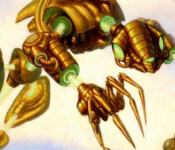
Darksteel: Transference Review (Part 2 of 2)
Modular is the name of the game as I prepare to take on Sam and playtest Transference. Certainly the ability to shift +1/+1 counters about is exactly the kind of “waste not, want not” strategy that can lead to victory, but how does the deck stack up? To find out, she shuffled up the White/Green Swarm & Slam.

Darksteel: Transference Review (Part 1 of 2)
In August of 2009, the second From the Vaults product was released to considerable fanfare. Unlike the previous From the Vaults: Dragons, this was a rogues’ gallery of sorts, a wretched hive of scum and villainy selected from throughout Magic’s long history. Some, like the Kird Ape or Serendib Efreet, seemed innocuous once removed from historical context. Others had a much more malignant pedigree.
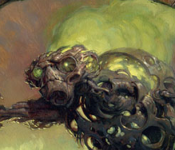
Darksteel: Mind Swarm Review (Part 2 of 2)
We’re back to the world of Mirrodin as we kick off our Darksteel reviews! We begin with the playtest of Mind Swarm, a Black weenie and discard construction. Joining me at the table is Jimi, who’s happy to pilot the mono-Red Master Blaster. Both colours play aggressively, but today only one will play for keeps!
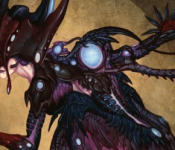
Darksteel: Mind Swarm Review (Part 1 of 2)
In October of 2000, Wizards of the Coast released a new compilation set called Beatdown. Designed to highlight some of the biggest, fattest creatures in the history of the game, the two decks of this Duel Decks antecedent featured cards like the Ernham Djinn and Sengir Vampire, and encouraged play in the red zone with reckless abandon. Nestled amongst the other Red cards in the set was the game’s first-ever “Y-spell,” not counting anything with a silver border. Except it wasn’t a new spell- just an old one, re-costed.

Mirrodin: Bait & Bludgeon Review (Part 2 of 2)
Our final match of the set, as we prepare to take our (very temporary) leave of Mirrodin, at least until the release of New Phyrexia right around the corner. For our final showdown, I’ve got Sam and Sacrificial Bam to look forward to, while I pilot the fun-with-affinity deck Bait & Bludgeon. One of our readers recently commented that the thing they enjoyed most about this series of reviews is that it has permitted those of us who weren’t active players during this release to see what Mirrodin was like before the Phyrexian plans started to hatch. It might well be so that Wizards had the Scars of Mirrodin-block sequel in mind when they said goodbye to this metallic world neatly seven years ago, but for many of us this is a first-time exploration of a world grown only recently familiar.
With that sentiment in mind we squared off for the customary three games, and here are our notes.
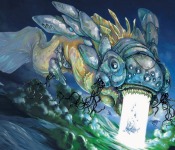
Mirrodin: Bait & Bludgeon Review (Part 1 of 2)
Mirrodin introduced a few noteworthy mechanics to the game, one of which has become ‘evergreen’ (or core set mechanic) and another which has something of a black mark attached to it. It’s hard to imagine the contemporary game without Equipment, but prior to Mirrodin that artifact type didn’t exist. You might have cards that simulated it, ranging from Ashnod’s Battle Gear to Flaming Sword (which actually was a creature aura). Indeed, even at the start of the game there was a certain flavour gap between artifacts that were obviously player-focused (like, say, Sunglasses of Urza) and those that might almost be considered proto-Equipment like the Helm of Chatzuk and Illusionary Mask. Mirrodin finally did away with that rather awkward disconnect and made Equipment explicit.
Another characteristic of the set was the entwine ability. Much less interesting than the Equipment, entwine was essentially a bi-modal variation of kicker. Kicker, introduced in 2000’s Invasion block, was an optional cost attached to a card that gave you additional effect if its optional cost was paid. Look at Agonizing Demise, for instance- it kills a creature, and if you pay the kicker it will also deal damage to that creature’s controller. The first part (the spell’s effect) is fixed, but the optional part is the “kicker.”




